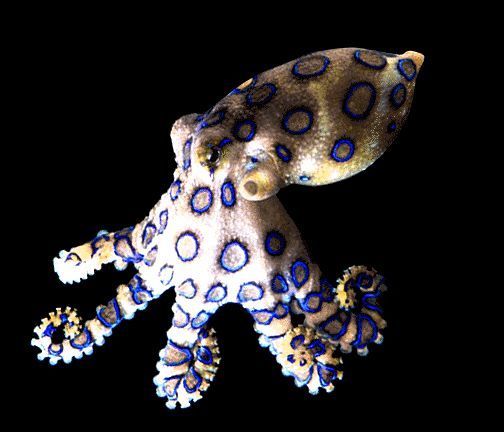The blue ring “Octopussy”
Was the Pet Blue Ring Octopus in the James Bond Movie Octopussy Real or a Prop?

Welcome to the intriguing world of the blue ring octopus! In this article, we dive deep into the question of whether the pet blue ring octopus in the James Bond movie “Octopussy” was real or simply a prop. These small but deadly creatures have captured the imagination of both moviegoers and nature enthusiasts alike. We will explore the fascinating characteristics of the blue ring octopus, its venomous nature, and shed light on the decision behind using a prop in the film. So, join us on this journey as we unravel the mystery surrounding the blue ring octopus of “Octopussy.
Key Takeaways
- The blue ring octopus is a visually striking marine creature known for its vibrant blue rings and deadly venom.
- In the James Bond movie “Octopussy,” the pet blue ring octopus was portrayed by a prop due to the risks associated with handling live specimens.
- Responsible filmmaking choices prioritize the safety of the cast and crew, often relying on realistic props and special effects.
- The blue ring octopus serves as a reminder of the delicate balance between beauty and danger in the natural world.
- It is essential to respect the venomous nature of the blue ring octopus and avoid unnecessary interactions to prevent harm.
The Blue Ring Octopus: A Deadly Beauty
The blue ring octopus, belonging to the genus Hapalochlaena, is a mesmerizing creature that captivates both scientists and nature enthusiasts alike. Despite its small size, typically ranging from 5 to 8 inches in length, this marine marvel possesses an incredible allure with its stunningly vibrant blue rings. However, beneath its striking appearance lies a deadly secret. The blue ring octopus is renowned for its potent venom, making it one of the most venomous creatures in the world. Found primarily in the Pacific Ocean, particularly around Australia and Southeast Asia, this remarkable cephalopod serves as a reminder of nature’s capacity to combine beauty and danger in a single, awe-inspiring package.
The Octopussy Connection
In the James Bond movie “Octopussy,” a pet blue ring octopus plays a pivotal role. The film, released in 1983, features a complex plot involving a Fabergé egg, a circus, and international espionage. The blue ring octopus appears in several scenes, showcasing its vibrant blue rings and venomous potential. But was the octopus portrayed in the film real or a cleverly designed prop?
The Reality: A Prop, Not a Live Octopus
Despite its convincing appearance, the blue ring octopus in “Octopussy” was indeed a prop. Filmmakers opted for a practical approach to ensure the safety of the cast and crew. The decision to use a prop was primarily due to the deadly nature of the real blue ring octopus. Handling a live specimen would have posed significant risks, given its potent venom and the potential harm it could cause.
The Importance of Accuracy in Filmmaking
While the decision to use a prop instead of a live blue ring octopus might disappoint some viewers, it is essential to recognize the responsible filmmaking choices made to ensure the safety of everyone involved. Movies often rely on props and special effects to depict dangerous or exotic animals without subjecting anyone to unnecessary risks. In the case of the blue ring octopus, the prop allowed for a visually stunning representation while maintaining a controlled environment.
Movie Props: A Realistic Approach
Creating realistic props for movies requires skilled craftsmen and designers who strive for authenticity. In the case of the blue ring octopus, special effects artists meticulously crafted a lifelike replica, paying attention to every detail, including its characteristic blue rings. This level of dedication showcases the commitment of filmmakers to immerse viewers in a believable cinematic experience.
The Legacy of “Octopussy”
Although the pet blue ring octopus in “Octopussy” was not real, it left a lasting impression on audiences worldwide. The film’s portrayal of this unique and deadly creature contributed to the mystique surrounding the blue ring octopus and sparked interest in its natural habitat and behaviors. It also highlighted the need for accurate representation and responsible filmmaking, ensuring the safety of both humans and animals involved in the production.
FAQ: Frequently Asked Questions about the Blue Ring Octopus
1. What makes the blue ring octopus venomous?
The blue ring octopus possesses a powerful venom that sets it apart from other marine creatures. Within its vibrant blue rings lies a neurotoxin called tetrodotoxin, which is incredibly potent. This toxin targets the nervous system, blocking nerve impulses and leading to paralysis. Even a small amount of this venom can have severe effects on its prey or potential threats, including humans. It is crucial to exercise extreme caution when encountering this fascinating but dangerous cephalopod.
2. How does the blue ring octopus use its venom?
When hunting, the blue ring octopus employs its venom to immobilize and subdue its prey. It injects the neurotoxin into its victims using its beak-like mouth, which breaks the skin and allows the venom to enter the body. The venom quickly takes effect, paralyzing the prey and rendering it helpless. This method allows the blue ring octopus to capture and consume its food without much resistance. It is essential to respect the lethal potential of the blue ring octopus and avoid any unnecessary interactions to prevent harm.
3. Can the blue ring octopus be kept as a pet?
While the allure of owning a blue ring octopus as a pet may be tempting, it is crucial to emphasize that it is not suitable or safe to keep these creatures in captivity. Not only do they have specific environmental requirements that are challenging to replicate, but their venomous nature poses a significant risk to humans. Handling a blue ring octopus, even unintentionally, could lead to a potentially life-threatening situation due to the potency of its venom. Therefore, it is best to appreciate these fascinating creatures from a safe distance in their natural habitats.
4. Are there different species of blue ring octopus?
Yes, within the genus Hapalochlaena, there are several recognized species of blue ring octopus. The most well-known species include Hapalochlaena maculosa, found in Australia, and Hapalochlaena lunulata, found in Southeast Asia. While these species share many similarities, such as their venomous nature and vibrant blue rings, there may be slight variations in their appearance and behavior. Scientists continue to study these fascinating creatures to better understand their taxonomy and ecological roles in their respective habitats.
5. How does the blue ring octopus defend itself?
The blue ring octopus has multiple defense mechanisms to protect itself from potential threats. Its first line of defense is its venomous bite. When threatened, the octopus will display its vivid blue rings as a warning sign, signaling its potential danger. If the warning is not heeded, the blue ring octopus may resort to biting as a means of defense. Additionally, it can change its body color and texture to blend into its surroundings, making it challenging to detect. These strategies, combined with their venomous bite, help the blue ring octopus fend off predators and ensure its survival.
6. What should I do if I encounter a blue ring octopus in the wild?
If you come across a blue ring octopus while diving or exploring marine environments, it is crucial to exercise extreme caution. Do not attempt to touch or handle the octopus, as even the slightest contact can result in a dangerous bite. Maintain a safe distance and avoid provoking or agitating the creature. It is always best to respect the natural behavior and habitat of the blue ring octopus and observe from a distance. If you suspect a bite or encounter any symptoms of envenomation, seek immediate medical attention, as the effects of the venom can be severe.
7. Can the venom of a blue ring octopus be lethal to humans?
Yes, the venom of the blue ring octopus can indeed be lethal to humans. The neurotoxin, tetrodotoxin, present in its venom, acts on the nervous system and can lead to respiratory failure, ultimately causing death in severe cases. Prompt medical treatment is essential if envenomation occurs. It is vital to remember that prevention is the best approach. By avoiding direct contact and respecting the blue ring octopus’s space, you can significantly reduce the risk of being bitten and envenomed.
8. What are the main habitats of the blue ring octopus?
The blue ring octopus prefers shallow, tropical waters as its primary habitat. It can be found in various marine environments, including coral reefs, tide pools, and sandy or rocky seabeds. These cephalopods often hide in crevices, under rocks, or in empty shells, relying on their exceptional camouflage skills to blend in seamlessly with their surroundings. Their choice of habitat provides them with ample opportunities to hunt for prey and seek shelter from potential predators.
9. How long do blue ring octopuses typically live?
The lifespan of blue ring octopuses can vary depending on species and environmental factors. On average, they tend to live for about one to two years in the wild. However, due to the challenges associated with studying these elusive creatures in their natural habitats, precise data on their lifespan remains limited. It is worth noting that the blue ring octopus has a relatively short life span, which further emphasizes the importance of conserving their habitats to ensure their continued existence.
10. What are some other interesting facts about the blue ring octopus?
Apart from its venomous nature, the blue ring octopus possesses several intriguing characteristics. For example, it has the ability to change both its color and texture, allowing it to blend seamlessly with its surroundings. This remarkable camouflage serves as a means of protection and helps the octopus remain hidden from potential threats. Additionally, blue ring octopuses are highly intelligent creatures, displaying complex behaviors and problem-solving skills. Their intelligence, coupled with their striking appearance, makes them a subject of great interest among researchers and marine enthusiasts.
Conclusion
While the pet blue ring octopus in the James Bond movie “Octopussy” may have been a prop, its portrayal left a lasting impact on viewers’ minds. This small but lethal creature, with its vibrant blue rings, serves as a symbol of the awe-inspiring wonders and hidden dangers that exist in our oceans. The decision to use a prop rather than a live octopus was a responsible choice, prioritizing the safety of everyone involved in the film’s production.
Beyond the realm of fiction, the blue ring octopus reminds us of the importance of accurate representation and responsible filmmaking practices. Movies have the power to ignite curiosity and raise awareness about the incredible diversity of life on our planet. By showcasing the blue ring octopus in “Octopussy,” filmmakers shed light on this unique creature and stimulated interest in its natural habitat and behaviors.
As we continue to explore the wonders of the natural world, let us appreciate the beauty and intricacies of creatures like the blue ring octopus while respecting their boundaries. By understanding and protecting these fascinating marine creatures, we can ensure their survival and preserve the awe they inspire in us for generations to come.









